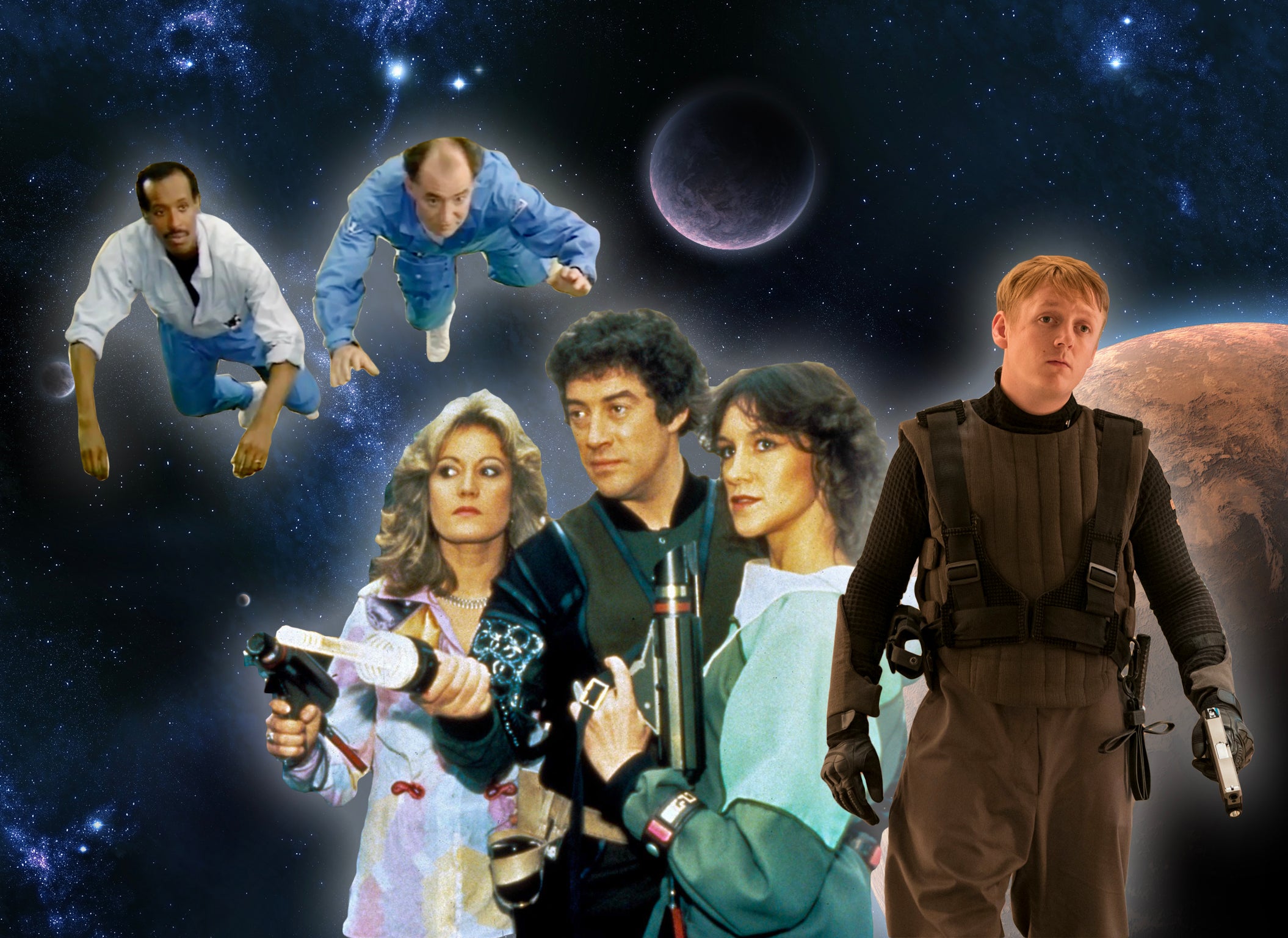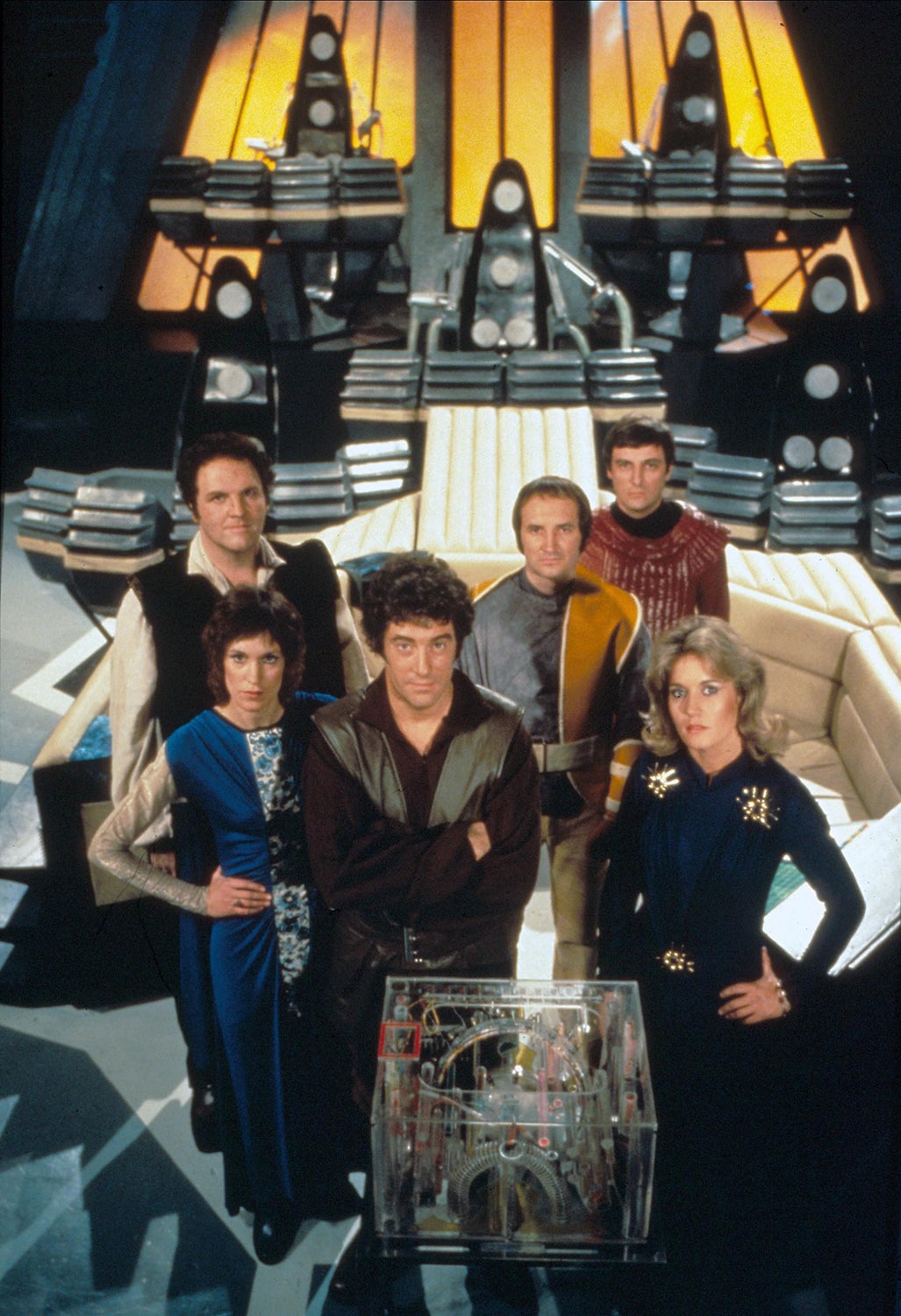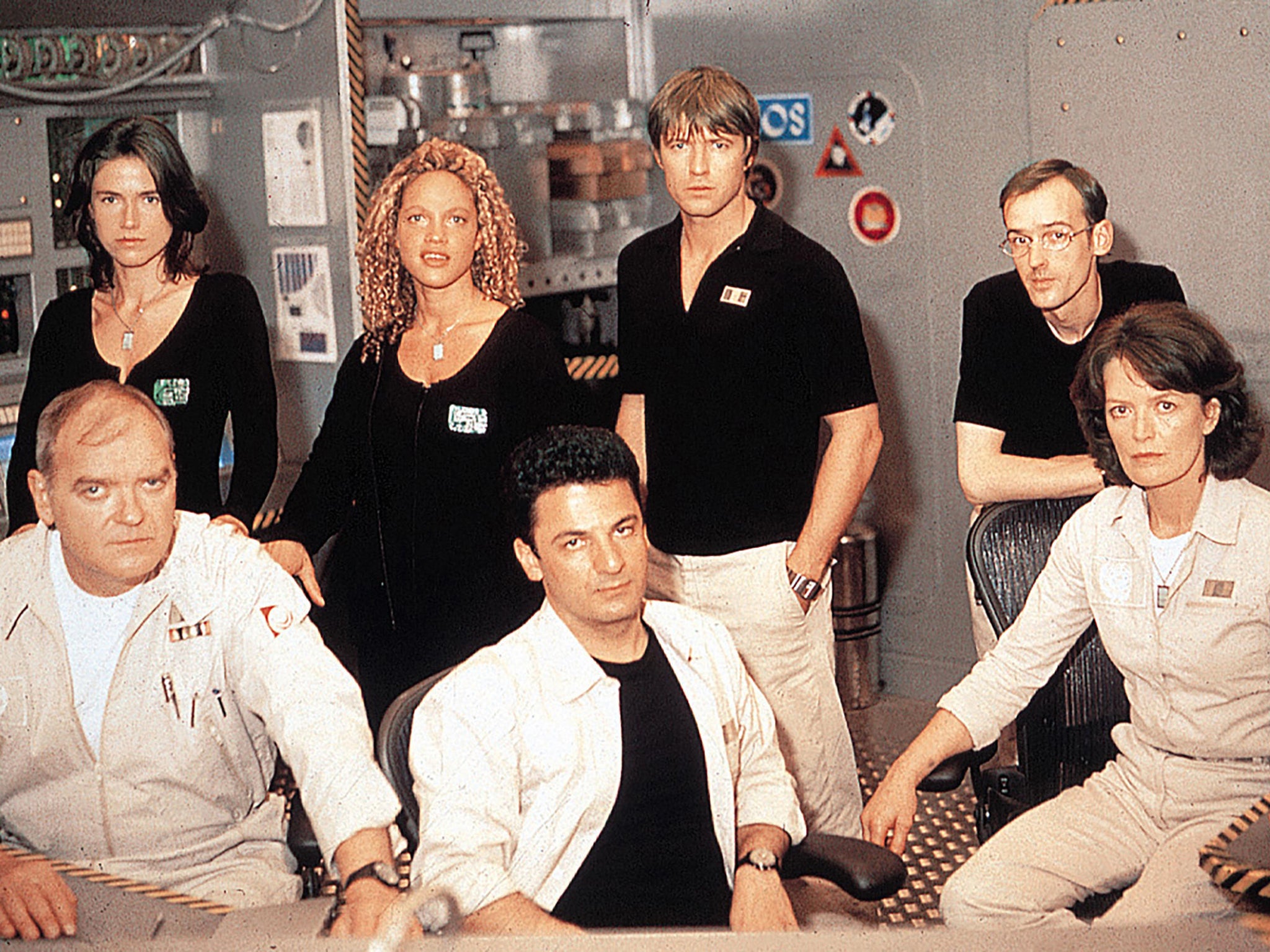‘We did it cheaply – you could probably tell’: How Britain fell in love with the rickety, low-budget sci-fi show
As Sky One launches the homegrown space series Intergalactic, Ed Cumming explores the unique appeal of ‘mostly indoors’ British sci-fi such as Blake’s 7 and Star Cops, with insight from the people that made them


Blame Doctor Who. When they arrived in 1963, the Time Lord and his chums didn’t merely create a franchise that would dominate British TV for more than 50 years – they spawned an entire universe of tonally imitative series set in space. From Blake’s 7 and Space Island One to Star Cops and Outcasts, UK TV schedules have been littered with these curiosities. With their rattling sets, iffy costumes and eccentric English charm, we might fondly call such shows “Mibs”, or Mostly Indoors British Sci-fi.
Another may be on the way in the form of Sky One’s space-prison drama Intergalactic, which begins tonight. While they differ in their specifics, these programmes share a love of big themes delivered on tight budgets. They’re also more liked than initial critical reception tends to suggest.
It stems from a paradox at the heart of the genre. For audiences, a futuristic setting conjures visions of spectacle, elaborate costumes and faraway locations, all augmented with cutting edge technology and special effects. In Hollywood, sci-fi has long pushed the envelope of what is possible in filmmaking. For TV producers on a tight leash, however, mostly indoor sci-fis have a different quality. When outside movement is limited by an infinite hostile void, you can film the whole thing in a tiny studio. Viewers get big ideas. You get great value. Everyone wins.
One of the earliest was Blake’s 7, which arrived on BBC One in January 1978 and ran for four series. It detailed the adventures of a small band of renegades battling the totalitarian Federation. Despite lukewarm reviews, it still got audiences of 10 million, which these days only Line of Duty or a royal wedding can aspire to. It also enjoyed a long afterlife, in Britain and America but also in Russia and eastern Europe, where it was aired behind the Iron Curtain. “People were very critical of it, but people are critical of everything,” says actor Michael Keating, who played the weaselly Vila Restal. “We had a wonderful time making it, and I think it worked. The characters were all very different. They weren’t typical heroes.”
Although Blake’s 7 came out a year after the first Star Wars film, there was no mistaking their different levels of ambition. “[Blake’s 7] was very much on a less grand budget than Hollywood films,” Keating says. “It was the BBC! Although we went all over the galaxy, it was mainly Betchworth Quarry. The whole thing was very make-do-and-mend, more like rep theatre than Hollywood, but many of us had come from rep theatre, so we had been doing that for years. I started out at the Nottingham Playhouse, where we would make our own costumes and help out with the sets. It’s more of a laugh when the scenery is falling down.”
Too much money can be actively disruptive, says Mike Kelt, one of Britain’s leading effects gurus. Kelt made his name on Blake’s 7, Star Cops and Doctor Who. Today he runs Artem, which has provided effects for everything from Captain America: The First Avenger to Hot Fuzz.
“A huge budget does not mean fantastic sci-fi,” he says. “Creativity is the key to a good end product, not money. Big budget productions have a tendency to do things in a costly way as a matter of default. Smaller budgets are often more interesting to work on as they present a challenge, and with that comes satisfaction.
“When I started out, everything was done in some way physically,” he adds. “If a ship needed to fly through space it was set up with a black cyclorama paper background and backlit holes punched through it for stars, while the craft was flown through on wires. There was joy in the experimentation, trying to achieve new things. In the early days the simplicity made it relatively easy to try to solve a problem. Now the techniques need years of training, and the jobs are so specialised that nobody is involved from start to finish.”
One of Kelt’s directors on Star Cops was Graeme Harper, a filmmaker with the rare distinction of having worked on both the original series of Doctor Who and its 21st-century revival. “There are people who want to watch [sci-fi] for the amazing effects, but everyone wants a good story,” he says. “If the story is good, it will still get through. People love stories. The effects are a bonus.” Star Cops, which began in 1985, was created by fellow Who alumnus Chris Boucher, and was essentially a detective show in space. It ran for a single series.

Watch Apple TV+ free for 7 day
New subscribers only. £9.99/mo. after free trial. Plan auto-renews until cancelled.
ADVERTISEMENT. If you sign up to this service we will earn commission. This revenue helps to fund journalism across The Independent.

Watch Apple TV+ free for 7 day
New subscribers only. £9.99/mo. after free trial. Plan auto-renews until cancelled.
ADVERTISEMENT. If you sign up to this service we will earn commission. This revenue helps to fund journalism across The Independent.
“Star Cops was fabulous,” Harper says. “There was money, and the lighting and the crew really pulled their finger out to do something interesting. The show had a huge audience, but I don’t know if it was loved or wanted by the BBC. There’s a huge demand for science fiction but in the Eighties they didn’t have as much faith as they would today. This was a time when the BBC didn’t know what to do with Doctor Who, and were trying to sideline it.”

Like Blake’s 7, Star Cops met with critical ambivalence. The Times said it had “neither the campiness of Star Trek nor the imagination of Doctor Who to overcome its technical limitations”. For David Calder, who starred as Commander Nathan Spring, however, it was ahead of its time. “We laid down a few markers,” he says. “It was multiethnic and multiracial in its casting. We tried to deal with space travel in a serious way.” One of the technological features was Commander Spring’s black box communicator, which ended up anticipating the iPhone by several decades.
“It was literally a piece of wood painted black, which I could talk to and it would give information or play music or whatever,” Calder says. “Years later I was playing Shylock in Stratford and this guy came up to me in the pub afterwards to tell me that he worked in tech and recognised me from Star Cops. They’d been working on replicating Commander Spring’s black box for a long, long time.”
He concedes that not everything about the production was so avant-garde. “We all had Kirby wire training for the zero-gravity scenes, but the wires then had to be painted out frame by frame. In the end, the best bit of gravity-free was me just doing slow motion with my legs and arms. And I did have to ask the design department at one point whether they thought a female space police officer would be wearing earrings inside her helmet.”
Few series encapsulate the spirit of Mostly Indoors British Sci-Fi as neatly as Space Island One, Intergalactic’s spiritual predecessor, an Anglo-German production that ran for two series from 1998. Like Star Cops, it eschewed fantastical elements for a more scientifically grounded approach, with the respected SF author Stephen Baxter onboard as an adviser. Many of its storylines tried to credibly riff on the possibilities of science in space.
“We did it exceptionally cheaply,” explains writer Andrew Maclear. “You can probably tell by looking at it. The set was built in a warehouse next to the airport, so we’d have to pause every time a plane took off.” The Isle of Man was offering tax breaks to production companies, so the show’s cast and crew were contracted for a whole year of filming. “Everyone lived together in this golf hotel, so you were filming all day and then going out at night. It was good fun but by the end I had slightly written myself out. We were doing an episode every nine days.”
One of its stars was Angus MacInnes, who was already a cult figure in sci-fi thanks to his role as the Y-Wing squadron commander Gold Leader in Star Wars: A New Hope. “Space Island One was a really nice idea,” he tells me. “But as soon as we started working, the scripts started to drift. They were trying to introduce Doctor Who weirdness to hard sci-fi. I said, ‘This is a problem, because you’re going to fall between two stools.’ You can’t fool the fans. And the art department were hopeless. They had keyboards up on the flight deck. I told them the future would be touchscreen and they didn’t know what I was talking about. It was breathtaking. Another script had a computer that ran on oil. In a way I was out of my depth, because I was used to working with serious professionals.”

His co-star Indra Ové has fonder memories, partly for personal reasons: during those long months on the Isle of Man, she met her husband Oliver, who was working as a junior crew member. Like MacInnes, Ové has also seen how the other half lives, in sci-fi terms. She played a First Order officer in Star Wars: The Rise of Skywalker, was decapitated in the opening moments of Resident Evil and had a memorable cameo in The Fifth Element as a flight attendant beguiled by Chris Tucker’s Prince-esque DJ, Ruby Rhod. For Ové, sci-fi has been a steady source of opportunities, and a rare space where it’s been an advantage not to fit the Hollywood mould.
“I’ve got quite an extraordinary look,” Ové says. “I’m mixed-race and have brown curly hair and green eyes. When I’ve gone for castings no one’s really known how to place me. I think that means in their eyes I’m quite open to this sci-fi world, and ‘the other’. It’s interesting to me to hear those conversations: ‘We can’t quite place you in the world now, but we can see you in the future.’ My brother is an artist and has done a lot of work with Afro-futurism. I wonder if I’m part of that movement.”
One thing all these series have in common is an enduring fanbase. Star Cops, Blake’s 7 and a host of other British sci-fi shows continue to enjoy an afterlife in the form of audiobooks produced by Big Finish, who also make stories for every conceivable iteration of Doctor Who. Old episodes are available online, and pored over on message boards and discussion forums decades after they aired. Few straight dramas enjoy such devoted fans, even the ones with bigger budgets and higher production values. What explains the appeal? MacInnes thinks the answer has something to do with escapism.
“There is an edge to it,” he says. “There are people, especially the people who feel most powerless, who want that escape. They want to go somewhere that isn’t ruled by the people who rule in real life.” When the outside world is a scary and unfamiliar place, it can be a comfort to stay within walls you know well. Even if they wobble a bit.
Join our commenting forum
Join thought-provoking conversations, follow other Independent readers and see their replies
Comments


Bookmark popover
Removed from bookmarks